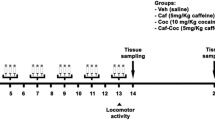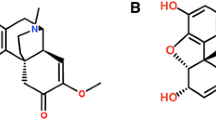Abstract
Rationale
Caffeine and other methylxanthines induce behavioral activation and anxiety responses in mice via antagonist action at A2A adenosine receptors. When combined with the opioid antagonist naloxone, methylxanthines produce a characteristic quasi-morphine withdrawal syndrome (QMWS) in opiate-naive animals.
Objectives
The aim of this study was to establish the role of A2A receptors in the quasi-morphine withdrawal syndrome induced by co-administration of caffeine and naloxone and in the behavioral effects of caffeine.
Methods
We have used A2A receptor knockout (A2AR−/−) mice in comparison with their wild-type and heterozygous littermates to measure locomotor activity in the open field and withdrawal symptoms induced by caffeine and naloxone. Naïve wild-type and knockout mice were also examined for enkephalin and dynorphin mRNA expression by in situ hybridization and for μ-opiate receptor by ligand binding autoradiography to check for possible opiate receptor changes induced by A2A receptor inactivation.
Results
Caffeine increases locomotion and anxiety in wild-type animals, but it has no psychomotor effects in A2AR−/− mice. Co-administration of caffeine (20 mg/kg) and naloxone (2 mg/kg) resulted in a severe quasi-morphine withdrawal syndrome in wild-type mice that was almost completely abolished in A2AR−/− mice. Heterozygous animals exhibited a 40% reduction in withdrawal symptoms, suggesting that there is no genetic/developmental compensation for the inactivation of one of the A2AR alleles. A2AR−/− and wild-type mice have similar levels of striatal μ-opioid receptors, thus the effect is not due to altered opioid receptor expression.
Conclusions
Our results demonstrate that A2A receptors are required for the induction of quasi-morphine withdrawal syndrome by co-administration of caffeine and naloxone and implicate striatal A2A receptors and μ-opiate receptors in tonic inhibition of motor activity in the striatum.





Similar content being viewed by others
References
Bailey A, Ledent C, Kelly M, Hourani MO, Kitchen I (2002) Changes in spinal delta and kappa opiod systems in mice deficient in the A2A receptor gene. J Neurosci 22:9210–9220
Bailey A, Davis L, Lesscher HM, Kelly MD, Ledent C, Hourani SM, Kitchen I (2004) Enhanced morphine withdrawal and micro-opioid receptor G-protein coupling in A2A adenosine receptor knockout mice. J Neurochem 88:827–834
Berrendero F, Castane A, Ledent C, Parmentier M, Maldonado R, Valverde O (2003) Increase of morphine withdrawal in mice lacking A2A receptors and no changes in CB1/A2a double knockout mice. Eur J Neurosci 17:315–324
Butt NM, Collier HOJ, Cuthbert NJ, Francis DL, Saeed SA (1979) Mechanism of quasi-morphine withdrawal behavior induced by methylxanthines. Eur J Pharmacol 53:375–378
Capasso A (2000) Adenosine receptors are involved in the control of acute naloxone-precipitated withdrawal: in vitro evidence. Life Sci 66:873–883
Chen JF, Huang Z, Ma J, Zhu J, Moratalla R, Standaert D, Moskowitz MA, Fink JS, Schwarzschild MA (1999) A2A adenosine receptor deficiency attenuates brain injury induced by transient focal ischemia in mice. J Neurosci 19:9192–9200
Chen J-F, Beilstein M, Xu Y-H, Turner J, Moratalla R, Standaert DG, Aloyo VJ, Fink JS, Schwarzschild MA (2000) Selective attenuation of psychostimulant-induced behavioral responses in mice lacking A2A adenosine receptors. Neuroscience 97:195–204
Chen J-F, Moratalla R, Impagnatiello F, Grandy DK, Cuellar B, Rubinstein M, Beilstein M, Hackett E, Fink JS, Low MJ, Ongini E, Schwarzschild MA (2001) The role of D2 dopamine receptor (D2R) in A2A adenosine receptor (A2AR)-mediated behavioral and cellular responses as revealed by A2A and D2 receptor knockout mice. Proc Natl Acad Sci U S A 98:1970–1975
Chen J-F, Moratalla R, Yu L, Martín AB, Hackett E, Alberti I, Schwarzschild MA (2003) Inactivation of adenosine A2A receptors selectively attenuates amphetamine-induced behavioral sensitization. Neuropsychopharmacology 28:1086–1095
Collier HO, Francis DL, Henderson G, Schneider C (1974) Quasi-morphine abstinence syndrome. Nature 249:471–473
Collier HO, Curthbert NJ, Francis DI (1981) Character and meaning of quasi-morphine withdrawal phenomena elicited by methylxanthines. Fed Proc 40:1513–1518
Cowan A (1981) Quasi-morphine withdrawal syndrome: recent developments. Fed Proc 40:1489–1490
Daly JW, Fredholm BB (1998) Caffeine: an atypical drug of dependence. Drug Alcohol Depend 51:199–206
Dassesse D, Massie A, Ferrari R, Ledent C, Parmentier M, Arckens L, Zoli M, Schiffmann SN (2001) Functional striatal hypodopaminergic activity in mice lacking adenosine A2A receptors. J Neurochem 78:183–198
Dunwiddie TV, Masino SA (2001) The role and regulation of adenosine in the central nervous system. Annu Rev Neurosci 24:31–55
Fernández-González R, Moreira P, Bilbao A, Jimenez A, Pérez-Crespo M, Ramirez MA, Rodriguez De Fonseca F, Pintado B, Gutierrez-Adan A (2004) Long-term effect of in vitro culture of mouse embryos with serum on mRNA expression of imprinting genes, development, and behavior. Proc Natl Acad Sci U S A 101:5880–5885
Ferré S, Fredholm BB, Morelli M, Popoli P, Fuxe K (1997) Adenosine-dopamine receptor–receptor interactions as an integrative mechanism in the basal ganglia. Trends Neurosci 20:482–487
Fredduzzi S, Moratalla R, Monopoli A, Cuellar B, Xu K, Ongini E, Impagnatiello F, Schwarzschild MA, Chen J-F (2002) Persistent behavioral sensitization to chronic l-dopa requires A2A adenosine receptors. J Neurosci 22:1054–1062
Fredholm B, Ijzerman AP, Jacobson KA, Klotz KN, Linden J (2001) International union of pharmacology: XXV. Nomenclature and classification of adenosine receptors. Pharmacol Rev 53:527–552
Grande C, Zhu H, Martin AB, Lee M, Ortiz O, Hiroi N, Moratalla R (2004). Chronic treatment with atypical neuroleptics induces striosomal FosB/DeltaFosB expression in rats. Biol Psychiatry 55:457–463
Grant SJ, Redmond DE (1982) Clonidine suppresses methylxanthine induced quasi-morphine withdrawal syndrome. Pharmacol Biochem Behav 17:655–658
Haas HL, Selbach O (2000) Functions of neuronal adenosine receptors Naunyn-Schmiedebergs Arch Pharmakol 362:375–381
Halimi G, Devaux C, Clot-Faybesse O, Sampol J, Legof L, Rochat H, Guieu R (2000) Modulation of adenosine concentration by opiod receptor agonists in rat striatum. Eur J Pharmacol 398:217–224
Halldner L, Aden U, Dahlberg V, Johansson B, Ledent C, Fredholm BB (2004) The adenosine A1 receptor contributes to the stimulatory, but not the inhibitory effect of caffeine on locomotion: a study in mice lacking adenosine A1 and/or A2A receptors. Neuropharmacology 46:1008–1017
Hauber W (1998) Involvement of basal ganglia transmitter systems in movement initiation. Prog Neurobiol 56:507–540
Johansson B, Georgiev V, Fredholm BB (1997) Distribution and postnatal ontogeny of adenosine A2A receptors in rat brain: comparison with dopamine receptors. Neuroscience 80:1187–1207
Julián MD, Martín AB, Cuéllar B, Rodríguez De Fonseca F, Navarro M, Moratalla R, García-Segura LM (2003) Neuroanatomical relationship between type 1 cannabinoid receptors and dopaminergic systems in the rat basal ganglia. Neuroscience 119:309–318
Kaplan GB, Sears MT (1996) Adenosine receptor agonist attenuate and adenosine receptor antagonist exacerbate opiate withdrawal signs. Psychopharmacology 123:64–70
Kaplan GB, Coyle TS (1998) Adenosine kinase inhibitors attenuate opiate withdrawal via adenosine receptor activation. Eur J Pharmacol 362:1–8
Kaplan GB, Leite-Morris KA, Sears MT (1994) Alterations of adenosine A1 receptors in morphine dependence. Brain Res 657:347–350
Kase H (2001) New aspects of physiological and pathophysiological functions of adenosine A2A receptor in basal ganglia. Biosci Biotechnol Biochem 65:1447–1457
Kleven MS, Sheldom BS (1989) Modification of quasi-morphine withdrawal with serotonin agonists and antagonists: evidence for a role of serotonin in the expression of opiate withdrawal. Psychopharmacology 98:231–235
Ledent C, Vaugeois JM, Schiffmann SN, Pedrazzini T, El Yacoubi M, Vanderhaeghen JJ, Costentin J, Heath JK, Vassart G, Parmentier M (1997) Aggressiveness, hypoalgesia and high blood pressure in mice lacking the adenosine A2A receptor. Nature 388:674–678
Moratalla R, Robertson HA, Graybiel AM (1992) Dynamic regulation of NGFI-A (zif268, egr1) gene expression in the striatum. J Neurosci 12:2609–2622
Moratalla R, Vickers EA, Robertson HA, Cochran BH, Graybiel AM (1993) Coordinate expression of c-fos and jun B is induced in the rat striatum by cocaine. J Neurosci 13:423–433
Moratalla R, Xu M, Tonegawa S, Graybiel AM (1996) Cellular responses to psychomotor stimulant and neuroleptic drugs are abnormal in mice lacking the D1 dopamine receptor. Proc Natl Acad Sci U S A 10:14928–14933
Moreau JL, Huber G (1999) Central adenosine A2A receptors: an overview. Brains Res Rev 31:65–82
Navarro M, Lizasoain I, Leza JC, Lorenzo P (1991) An original method for assessment of the jumping test. Methods Find Exp Clin Pharmacol 13:443–447
Neal BS, Sparber SB (1990) The serotonin antagonist ritanserin blocks quasi-morphine withdrawal at a time when mianserin is no longer effective. Psychopharmacology 100:258–266
Pavón N, Martín AB, Mendialdua A, Moratalla R (2005) ERK phosphorylation and FosB expression are associated to l-DOPA-induced dyskinesia in hemiparkinsonian mice. Biol Psychiatry (in press)
Paxinos G, Franklin KBJ (2004) The mouse brain stereotaxic coordinates 2nd edn. Elsevier, San Diego, California, USA
Pioli E, Sohr R, Meissner W, Barthe N, Gross CE, Bezard E, Bioulac BH (2004) Partial bilateral mesencephalic lesions affect D1 but not D2 binding in both the striatum and cortex. Neurochem Int 45:995–1004
Rebola N, Canas PM, Oliveira CR, Cunha RA (2005) Different synaptic and subsynaptic localization of adenosine A(2A) receptors in the hippocampus and striatum of the rat. Neuroscience 132:893–903
Ribeiro JA, Sebastiao AM, MendonÇa A (2003) Adenosine receptors in the nervous system: pathophysiological implications. Prog Neurobiol 68:377–392
Rivera A, Cuéllar B, Girón FJ, Grandy DK, de la Calle A, Moratalla R (2002) Dopamine D4 receptors are heterogeneously distributed in the striosomes/matrix compartments of the striatum. J Neurochem 80:219–229
Salem A, Hope W (1997) Effect of adenosine receptor agonist and antagonist on the expression of opiate withdrawal in rats. Pharmacol Biochem Behav 57:671–679
Solinas M, Ferré S, You ZB, Karcz-Kubicha, Popoli P, Goldberg SR (2002) Caffeine induces dopamine and glutamate release in the shell of the nucleus accumbens. J Neurosci 22:6321–6324
Soria G, Castañe A, Berrendero F, Ledent C, Parmentier M, Maldonado R, Valverde O (2004) Adenosine A receptors are involved in physical dependence and place conditioning induced by THC. Eur J Neurosci 20:2203–2213
Yano M, Steiner H (2005) Methylphenidate (Ritalin) induces homer 1a and Zif 268 expression in specific corticostriatal circuits. Neuroscience 132:855–865
Acknowledgements
This work has been supported by Plan Nacional Sobre Drogas and FIS (Red RTA, G03/05, and Red CIEN, C03/06) to R.M; M.N. and F.R.F and by the Spanish Ministerio de Educación y Ciencia, SAF2003-4864 and GEN2003-20651-C06-02 to RM and to F.R.F. The authors acknowledge the technical assistance of Luis Franco, Ana Isabel Tena, Coco Castuera and Oskar Ortiz. R. Moratalla, M. Navarro, and F. Rodríguez de Fonseca contributed equally for this work.
Author information
Authors and Affiliations
Corresponding author
Rights and permissions
About this article
Cite this article
Bilbao, A., Cippitelli, A., Martín, A.B. et al. Absence of quasi-morphine withdrawal syndrome in adenosine A2A receptor knockout mice. Psychopharmacology 185, 160–168 (2006). https://doi.org/10.1007/s00213-005-0284-0
Received:
Accepted:
Published:
Issue Date:
DOI: https://doi.org/10.1007/s00213-005-0284-0




